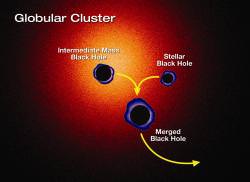Uh oh, this doesn’t sound good. It turns out there could be hundreds of rogue black holes, each weighing thousands of times the mass of the Sun, hurtling though the Milky Way. Oh, and they’d be almost impossible to spot.
Vanderbilt astronomer Kelly Holley-Bockelmann presented the results of a supercomputer simulation at the Winter meeting of the American Astronomical Society.
The research focused on modeling the controversial “intermediate mass” black holes. These are the theorized black holes that should form within globular star clusters, containing a few thousand times the mass of the Sun; much heavier than the stellar mass black holes, but a fraction the mass of the supermassive variety. Astronomers have been looking for them for years, and even after all that searching, they’ve only come up with a couple of tentative candidates. So maybe these black holes are all around us, kicked out of their globular clusters, free to wander the galaxy.
Scientists have been hard at work modeling what might happen as two black holes merge. This is the realm where Einstein’s theory of relativity comes into play because of the tremendous forces and masses involved.
The simulations predict that as two black holes come together to form a new, even more massive black hole, it should receive a tremendous “kick” because of the conservation of momentum. The newly formed black hole should actually get kicked right out of the globular cluster in a random direction as fast as 4,000 kilometres a second.
Since the escape velocity of a globular cluster is only about 100 km/s, that black hole won’t ever come back to its home.
Now, if this research is true, the roughly 200 globular clusters in the Milky Way might have spawned intermediate-sized black holes, and then ejected them in random directions into the galaxy. There are probably several hundred black holes wandering invisibly through our galaxy.
Now don’t get too scared, “these rogue black holes are extremely unlikely to do any damage to us in the lifetime of the Universe,” soothed Holly-Bockelmann. “Their danger zone, the Schwarzschild radius, is really tiny, only a few hundred kilometers. There are far more dangerous things in our neighborhood.”
Original Source: Vanderbilt News Release


oh thats good to hear!… Wait more things to wory about than a black hole?!?!?!?,oh right a pulsar light beam i think.
this story made BBC WORLD NEWS today. of course they made it sound like these things were just waiting to devour us all.
The Langoliers!
There cannot be rogue black holes in our galaxy. If there was a black hole passing by while a photograph was being taken, gravity from the black hole would bend light from the background stars and you would easily see the background distort. Since that’s never been noticed, there cannot be rogue black holes roaming around our galaxy (or any other large structure)
And something else is bothering me about black holes. I keep reading that you cannot go into it without gravity stretching you out to infinity. Gravity and acceleration are the same, so why not have a (theoretical) engine that can push you as fast as you’re falling. While the black hole is stretching you, the engine would be compressing you and you should survive a trip into the singularity
The “danger radius” of an intermediate mass black hole is much larger than the Schwarzschild radius. If a black hole with thousands of solar masses entered our solar system, it would seriously disrupt Earth’s orbit around the sun. We’d all die within months as the planet froze or baked.
It’s still extremely unlikely, though. There are many times more ordinary stars in our galaxy, and none of them have entered our solar system yet.
How do these scientists know if these black holes are ‘rogue’. I think they are quite friendly!
“How do these scientists know if these black holes are ‘rogue’. I think they are quite friendly!”
http://www.answers.com/rogue&r=67
look up the definition of rogue k. thx..